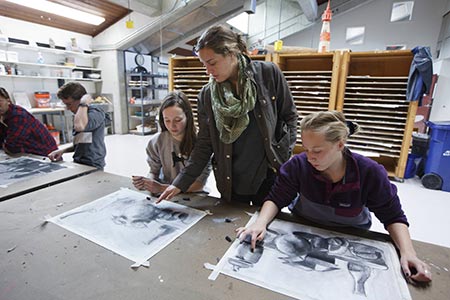 From an early age, Visual Arts teacher Molly Swain loved “everything artistic and everything athletic,” so it’s fitting she grew up to teach art and coach sports.
From an early age, Visual Arts teacher Molly Swain loved “everything artistic and everything athletic,” so it’s fitting she grew up to teach art and coach sports.
“If you asked my kindergarten teacher what I would be doing right now, they would name those two things as their expectations,” she said. “I felt a natural path toward teaching, and coaching felt like a natural combination with teaching.”
Knowing that she didn’t want to sacrifice either her love for art or sports, working in schools made sense. She grew up in Cambridge, where her mother’s job in architecture and her father’s basement workshop meant that art supplies were abundant in her house, and she “always felt affirmed” as being a talented artist.
While Swain was working toward her undergraduate degree in painting and sculpture, she always planned to receive her master’s in art education. She came to Milton as an assistant coach for the girls’ lacrosse program in 2013, then returned in the fall as head coach and a teacher in the Visual Arts Department. “I’ve pretty much dramatically changed my role every year,” she jokes.
Prior to arriving at Milton, Swain taught art in public school, where art teachers felt the pressure of the “curriculum justification that exists particularly in the art world. There’s not enough of a budget. It’s constantly threatened with cuts, and that felt so distinctly different from what an independent school can offer. Here, I’m supported and really encouraged to be innovative.”
Today, she teaches Architecture—a course she designed—as well as Class IV Visual Arts; she is also a Class III dean, an assistant coach for girls’ lacrosse and JV basketball, and she serves on the Department of Equity, Inclusion, and Justice team. Architecture as an academic subject could be taught as a science, math, or computer programming course, but Swain’s class is specifically about the art of architecture.
“What is unique about an art course is that everything you’re making is inherently yours,” she said. “We’re designing from the ground up, trying to articulate what it is that they value, what excites them about space. How do you inhabit and exist in space, and then, what do you want to build to project those values?”
This year, Swain also took on the role of director of professional learning, a leadership position on the Teaching and Learning Team. She coordinates professional development and helps to organize faculty events.
“It’s exciting to me because I love talking about why we’re teaching what we’re teaching,” she said. “We were doing that before the pandemic but it feels even more important now. I think Milton does a good job of having that conversation and constantly examining it. My role is to facilitate a team of teachers who are doing that work and then to facilitate a broader, internal professional development.”
Swain is also one of the chairs of AWARE (Alliance of White Anti-Racist Educators), a K–12 group of white faculty and staff who meet to discuss topics of anti-racism and nondiscrimination and explore how whiteness and white supremacy culture affect their lives and work.
“These interpersonal connections with colleagues across divisions encourage so much learning and growth,” she said. “There are meaningful and challenging conversations that have helped me redefine who I am as a teacher, and to help students even without having all the answers. It’s about trying to navigate when to just listen and when to share, when to be a model of not knowing; how to create a space where students can truly be their full selves. It takes a lot of work, and I’m still working on it.”
